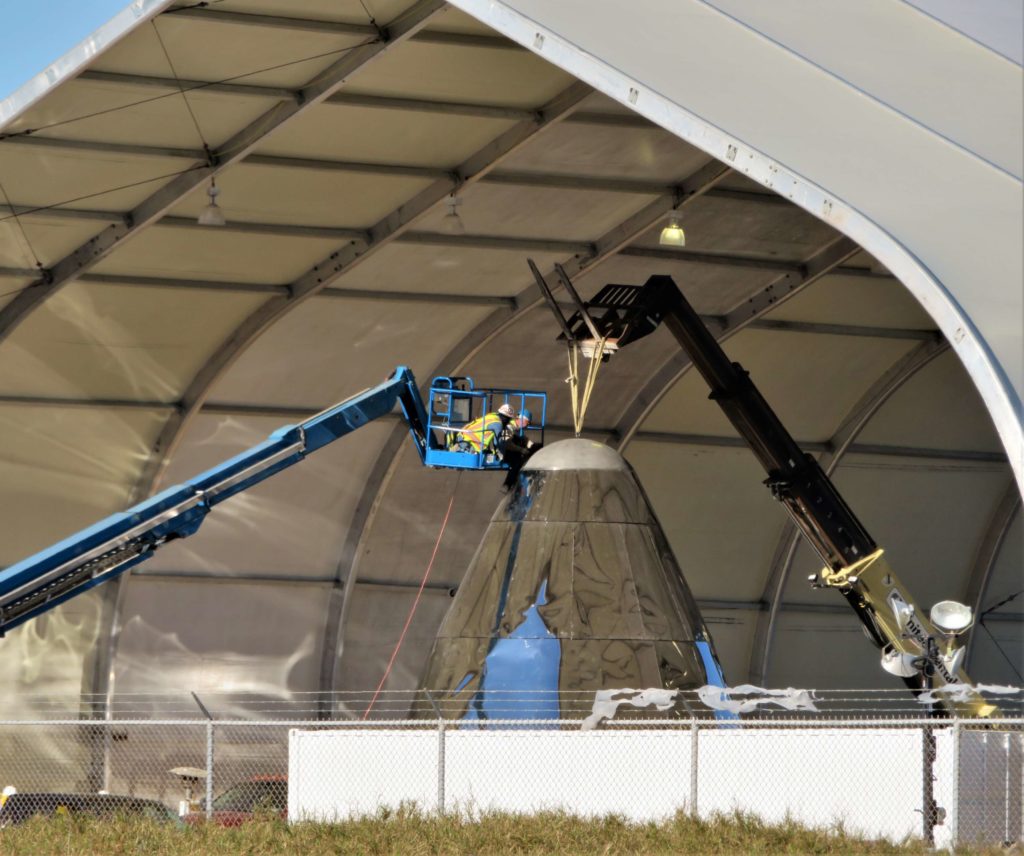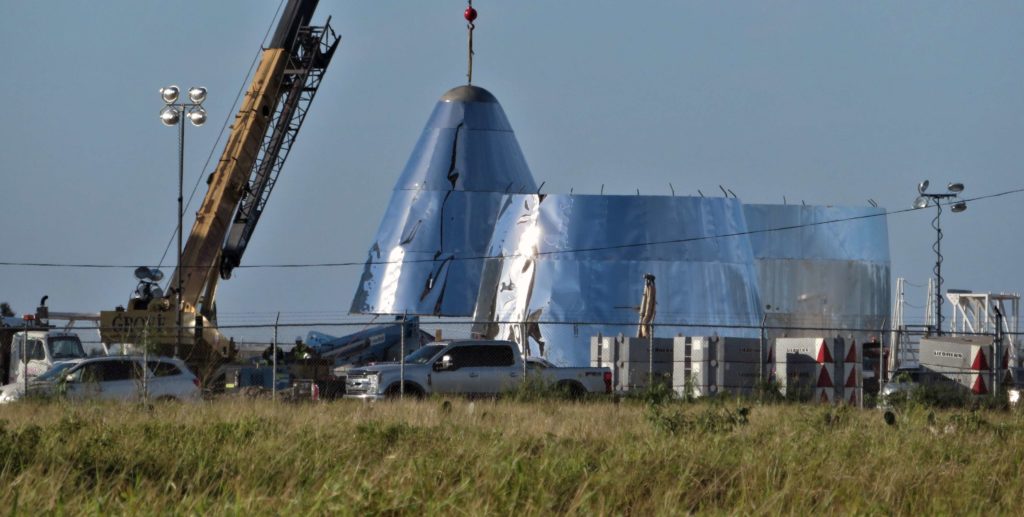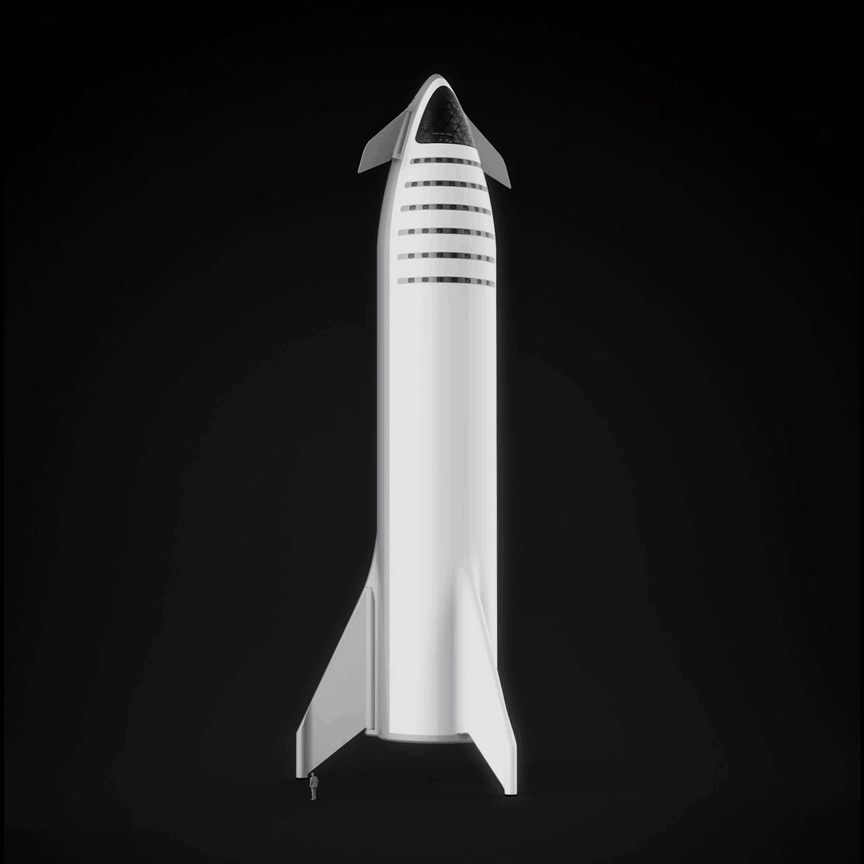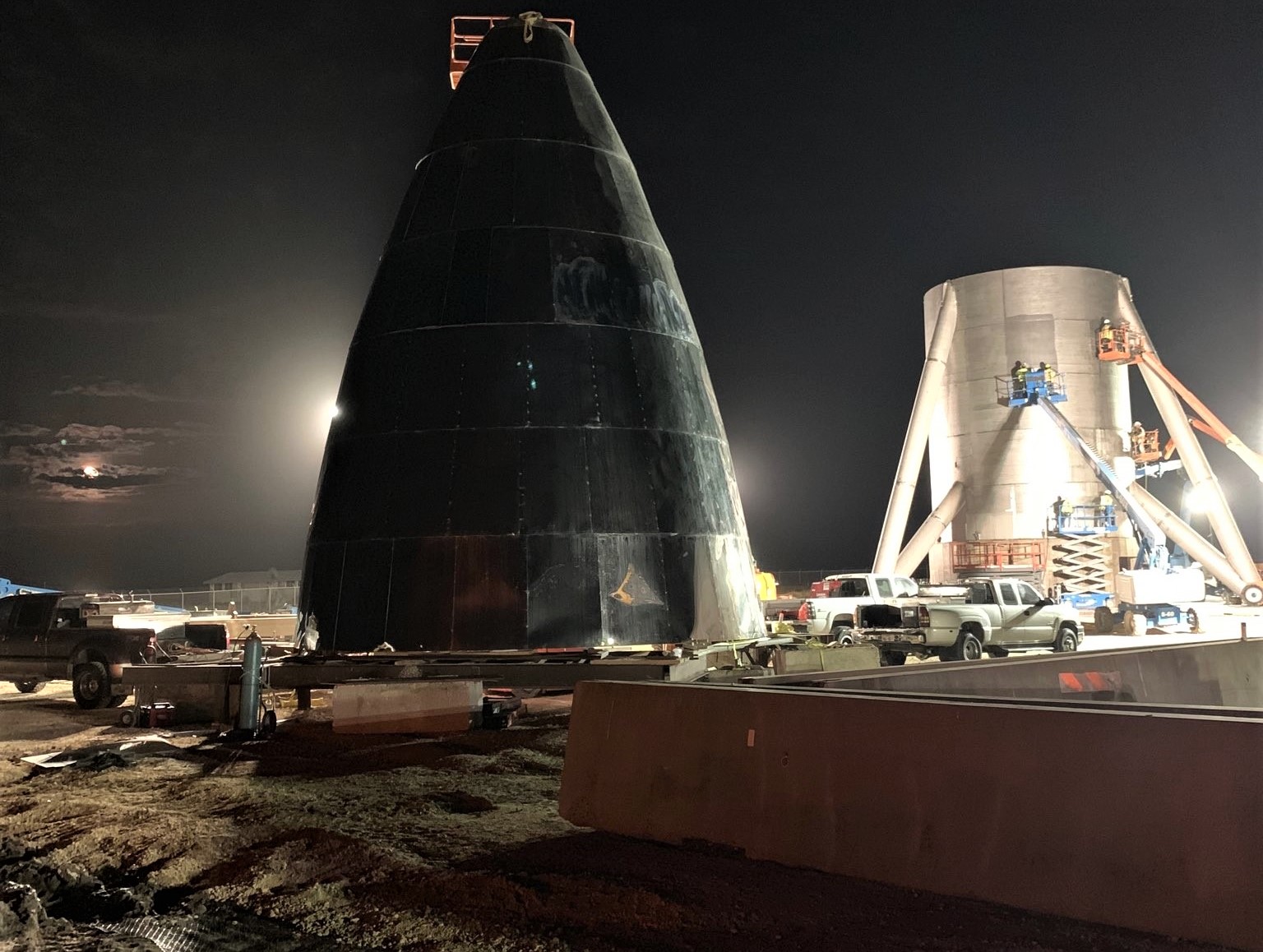
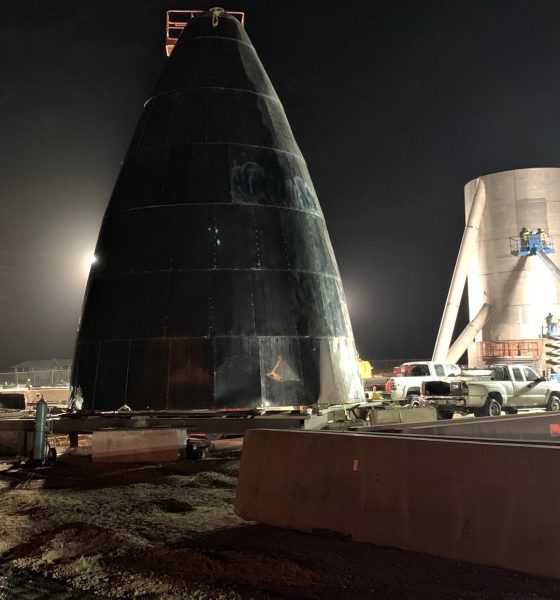
SpaceX
SpaceX CEO Elon Musk: Starship prototype to have 3 Raptors and “mirror finish”
Taking to Twitter once more to reveal additional information about SpaceX’s radically changing BFR/Starship prototype program, CEO Elon Musk has made an unexpected visit to the company’s South Texas BFR testing facilities to oversee rapid progress with a low-fidelity hop test prototype of the orbital Starship spacecraft.
Included in a handful of replies that followed the tweeted image, Musk described some of the key advantages of a stainless steel Starship – including mirror-like thermal reflectivity for hot reentries and a “usable” strength-to-mass ratio superior to carbon fiber – as well as features of prototype cousin.
Stainless Steel Starship pic.twitter.com/rRoiEKKrYc
— Elon Musk (@elonmusk) December 24, 2018
While the CEO did imply on Saturday that the Mars-focused Raptor engine had been what he described as “radically redesigned”, Musk’s statement that the Starship hopper will feature three Raptor engines does at least set a lower bound for the ship’s maximum gross takeoff weight when the time comes for it to take flight.
Yes. Radically redesigned Raptor ready to fire next month.
— Elon Musk (@elonmusk) December 22, 2018
While the suggestion that Raptor’s turbopumps (basically fuel pumps) would need at least 100,000 HP per engine seems to indicate that the flight design’s thrust has been appreciably uprated, a past figure of ~2000 kN (450,000 lbf) per engine suggests that Starship V0.1 could weigh as much as an entire Falcon 9 Block 5 rocket (~1.2 million pounds, 550,000 kg) and still having a solid 80-100% of Falcon 9’s liftoff thrust. Put simply, the rocket that appears to be coming together in the boonies of South Texas could rival almost any other liquid fuel rocket booster in service, while still being the testbed for BFR’s upper stage alone.
While it’s ambiguous if several additional comments applied to the Starship prototype, the final product, or both, Musk also indicated that some of the biggest benefits of a shift away from carbon composites to stainless steel would be relative ease with which the material handles extreme heating. Thanks to the fact that stainless steel can ultimately be polished to mirror-like levels of reflectivity and that mirrors are some of the most efficient reflectors of thermal energy (heat), shiny and unpainted steel would ultimately perform far better than carbon composites and could end up requiring “much less” heat shielding for the same performance.
- ¯\_(ツ)_/¯ (bocachicagal – NASASpaceflight)
- A conspicuous nosecone appears to have arisen inside SpaceX’s new Boca Chica tent, adjacent to what looks like a water tower with tube legs. (bocachicagal – NASASpaceflight)
- Boca Chica, 12/23/18. (NASASpaceflight /u/bocachicagal)
- It remains to be seen if BFR can be made as reusable and reliable as it will need to be to sustainably support interplanetary humans. (SpaceX)
- Starship – in its 2018 design iteration – seen landing on Mars atop pillars of Raptor flame. (SpaceX)
Perhaps most unintuitive is the fact that steel can apparently beat carbon composites when it comes to usable strength-to-weight ratios at supercool temperatures. According to Musk, steel also performs “vastly better” at high temperatures and appreciably better at room temperatures. A comment made on Saturday may lend additional credence to what seems at face value to contradict basic material intuition – at least some of the stainless steel SpaceX is examing would be a special (presumably SpaceX-engineered) alloy that has undergone what is known as cryogenic treatment, in which metals are subjected to extremely cold conditions to create some seriously unintuitive properties. Ultimately, cold-formed/worked or cryo-treated steel can be dramatically lighter and more wear-resistant than traditional hot-rolled steel.
Usable strength/weight of full hard stainless at cryo is slightly better than carbon fiber, room temp is worse, high temp is vastly better
— Elon Musk (@elonmusk) December 24, 2018
Combined with advanced new alloys and a uniquely strong handle on working with supercool propellant (likely transferable to cold-forming steel), SpaceX and CEO Elon Musk could have a true breakthrough on their hands, especially if it turns out that a great deal of deep thought, analysis, and refinement fed into these “radical” design changes. With Starship Alpha’s hop tests potentially beginning as early as March 2019, we won’t have long to wait to find out.
For prompt updates, on-the-ground perspectives, and unique glimpses of SpaceX’s rocket recovery fleet check out our brand new LaunchPad and LandingZone newsletters!

Elon Musk
Elon Musk gives nod to SpaceX’s massive, previously impossible feat
It was the booster’s 30th flight, a scenario that seemed impossible before SpaceX became a dominant force in spaceflight.
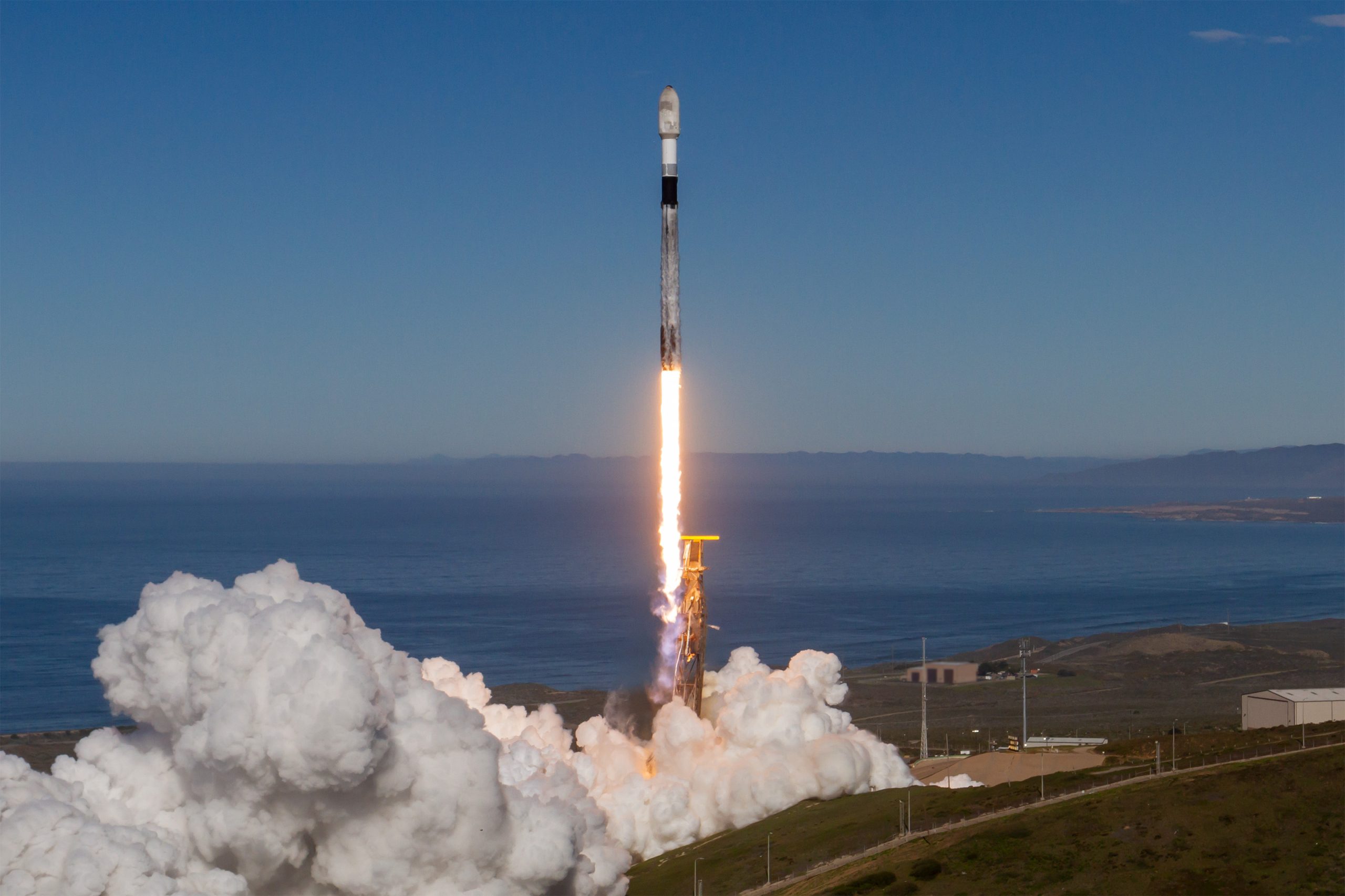
Elon Musk gave a nod to one of SpaceX’s most underrated feats today. Following the successful launch of the Transporter-15 mission, SpaceX seamlessly landed another Falcon 9 booster on a droneship in the middle of the ocean.
It was the booster’s 30th flight, a scenario that seemed impossible before SpaceX became a dominant force in spaceflight.
Elon Musk celebrates a veteran Falcon 9 booster’s feat
SpaceX completed another major milestone for its Smallsat Rideshare program on Friday, successfully launching and deploying 140 spacecraft aboard a Falcon 9 from Vandenberg Space Force Base. The mission, known as Transporter-15, lifted off two days later than planned after a scrub attributed to a ground systems issue, according to SpaceFlight Now. SpaceX confirmed that all payloads designed to separate from the rocket were deployed as planned.
The Falcon 9 used for this flight was booster B1071, one of SpaceX’s most heavily flown rockets. With its 30th mission completed, it becomes the second booster in SpaceX’s fleet to reach that milestone. B1071’s manifest includes five National Reconnaissance Office missions, NASA’s SWOT satellite, and several previous rideshare deployments, among others. Elon Musk celebrated the milestone on X, writing “30 flights of the same rocket!” in his post.
Skeptics once dismissed reusability as unfeasible
While rocket landings are routine for SpaceX today, that was not always the case. Industry veterans previously questioned whether reusable rockets could ever achieve meaningful cost savings or operational reliability, often citing the Space Shuttle’s partial reusability as evidence of failure.
In 2016, Orbital ATK’s Ben Goldberg argued during a panel that even if rockets could be reusable, they do not make a lot of sense. He took issue with Elon Musk’s claims at the time, Ars Technica reported, particularly when the SpaceX founder stated that fuel costs account for just a fraction of launch costs.
Goldberg noted that at most, studies showed only a 30% cost reduction for low-Earth orbit missions by using a reusable rocket. “You’re not going to get 100-fold. These numbers aren’t going to change by an order of magnitude. They’re just not. That’s the state of where we are today,” he said.
Former NASA official Dan Dumbacher, who oversaw the Space Launch System, expressed similar doubts in 2014, implying that if NASA couldn’t make full reusability viable, private firms like SpaceX faced steep odds.
Elon Musk
SpaceX’s Starship program is already bouncing back from Booster 18 fiasco
Just over a week since Booster 18 met its untimely end, SpaceX is now busy stacking Booster 19, and at a very rapid pace, too.

SpaceX is already bouncing back from the fiasco that it experienced during Starship Booster 18’s initial tests earlier this month.
Just over a week since Booster 18 met its untimely end, SpaceX is now busy stacking Booster 19, and at a very rapid pace, too.
Starship V3 Booster 19 is rising
As per Starbase watchers on X, SpaceX rolled out the fourth aft section of Booster 19 to Starbase’s MegaBay this weekend, stacking it to reach 15 rings tall with just a few sections remaining. This marks the fastest booster assembly to date at four sections in five days. This is quite impressive, and it bodes well for SpaceX’s Starship V3 program, which is expected to be a notable step up from the V2 program, which was retired after a flawless Flight 11.
Starship watcher TankWatchers noted the tempo on X, stating, “During the night the A4 section of Booster 19 rolled out to the MegaBay. With 4 sections in just 5 days, this is shaping up to be the fastest booster stack ever.” Fellow Starbase watcher TestFlight echoed the same sentiments. “Booster 19 is now 15 rings tall, with 3 aft sections remaining!” the space enthusiast wrote.
Aggressive targets despite Booster 18 fiasco
SpaceX’s V3 program encountered a speed bump earlier this month when Booster 18, just one day after rolling out into the factory, experienced a major anomaly during gas system pressure testing at SpaceX’s Massey facility in Starbase, Texas. While no propellant was loaded, no engines were installed, and no one was injured in the incident, the unexpected end of Booster 18 sparked speculation that the Starship V3 program could face delays.
Despite the Booster 18 fiasco, however, SpaceX announced that “Starship’s twelfth flight test remains targeted for the first quarter of 2026.” Elon Musk shared a similar timeline on X earlier this year, with the CEO stating that “ V3 is a massive upgrade from the current V2 and should be through production and testing by end of year, with heavy flight activity next year.”
Considering that Booster 19 seems to be moving through its production phases quickly, perhaps SpaceX’s Q1 2026 target for Flight 12 might indeed be more than feasible.
Elon Musk
Elon Musk shares SpaceX’s directive that destroys a prevalent media narrative
Musk’s comments followed Starlink’s initiatives for people affected by severe flooding in Indonesia and Cyclone Ditwah in Sri Lanka.

Elon Musk recently shared SpaceX’s standing policy to offer free Starlink service during natural disasters worldwide, highlighting the company’s commitment to pursue aid over profit during times of need.
Musk’s comments followed Starlink’s initiatives for people affected by severe flooding in Indonesia and Cyclone Ditwah in Sri Lanka.
Starlink activates free service in Indonesia and Sri Lanka
Starlink recently announced free service for those impacted by severe flooding in Indonesia’s Sumatra region, partnering with the government to deploy terminals rapidly to the hardest-hit areas. The offer extends to new and existing customers through December, restoring connectivity in zones where traditional networks have failed due to infrastructure damage.
Musk quoted the post on X, writing, “SpaceX standard policy is to make Starlink free whenever there is a natural disaster somewhere in the world. It would not be right to profit from misfortune.”
Starlink extended the same relief to Sri Lanka amid Cyclone Ditwah, coordinating with local authorities for additional support. The cyclone battered the island nation with heavy rains and winds, disrupting communications for thousands. Free access also lasts until year-end, emphasizing Starlink’s role in bridging gaps during crises.
“For those affected by the severe flooding in Indonesia and Sri Lanka in the aftermath of Cyclone Ditwah, Starlink is providing free service to new and existing customers through the end of December 2025. We’re also working with the Indonesian government to rapidly deploy terminals and restore connectivity to the hardest-hit areas on Sumatra, as well as with the Sri Lankan government to provide additional assistance,” Starlink wrote in a post on its official website.
Musk’s companies routinely provide aid
Musk’s firms have a track record of providing critical support in crises, often without fanfare, challenging portrayals of him as a comic book villain intent on enriching himself on the backs of a suffering populace. In January 2024 alone, Tesla opened Superchargers for free in Japan’s Hokuriku region after a magnitude 7.6 earthquake killed at least 55 and injured hundreds.
Similar efforts include Starlink deployments for the 2023 Maui wildfires, 2024 Hurricane Helene in North Carolina, and floods in Texas, where the service was used to help facilitate emergency coordination. These actions, which total millions in waived fees and logistics, demonstrate a proactive ethos among Musk’s companies, with Musk noting in past interviews that such aid stems from engineering solutions over optics.
The initiatives also provide a direct rebuttal of Musk’s characterization on mainstream media, which tends to lean negatively. This has become much more notable in recent years as Musk adopted more conservative policies. These negative sentiments came to a head earlier this year when Tesla stores, vehicles, and even some owners, were attacked during waves of anti-Tesla protests.

